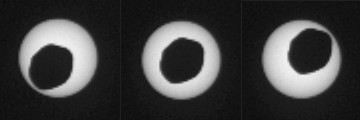Solar eclipses on Mars on:
[Wikipedia]
[Google]
[Amazon]
 The two moons of
The two moons of
 Due to the small size of Phobos (about ) and its rapid orbital motion, an observer on the surface of Mars would never experience a solar eclipse for longer than about thirty seconds. Phobos also takes only 7 hours 39 minutes to orbit Mars, while a Martian day is 24 hours 37 minutes long, meaning that Phobos can create two eclipses per Martian day. These are
Due to the small size of Phobos (about ) and its rapid orbital motion, an observer on the surface of Mars would never experience a solar eclipse for longer than about thirty seconds. Phobos also takes only 7 hours 39 minutes to orbit Mars, while a Martian day is 24 hours 37 minutes long, meaning that Phobos can create two eclipses per Martian day. These are
Eclipse of the Sun by Phobos
{{DEFAULTSORT:Solar Eclipses On Mars Solar eclipses by planet Mars Articles containing video clips
 The two moons of
The two moons of Mars
Mars is the fourth planet from the Sun and the second-smallest planet in the Solar System, only being larger than Mercury (planet), Mercury. In the English language, Mars is named for the Mars (mythology), Roman god of war. Mars is a terr ...
, Phobos and Deimos Deimos, a Greek word for ''dread'', may refer to:
* Deimos (deity), one of the sons of Ares and Aphrodite in Greek mythology
* Deimos (moon), the smaller and outermost of Mars' two natural satellites
* Elecnor Deimos, a Spanish aerospace company
* ...
, are much smaller than Earth's Moon
The Moon is Earth's only natural satellite. It is the fifth largest satellite in the Solar System and the largest and most massive relative to its parent planet, with a diameter about one-quarter that of Earth (comparable to the width of ...
, greatly reducing the frequency of solar eclipse
A solar eclipse occurs when the Moon passes between Earth and the Sun, thereby obscuring the view of the Sun from a small part of the Earth, totally or partially. Such an alignment occurs during an eclipse season, approximately every six month ...
s on that planet. Neither moon's apparent diameter
The angular diameter, angular size, apparent diameter, or apparent size is an angular distance describing how large a sphere or circle appears from a given point of view. In the vision sciences, it is called the visual angle, and in optics, it is ...
is large enough to cover the disk of the Sun, and therefore they are annular solar eclipse
A solar eclipse occurs when the Moon passes between Earth and the Sun, thereby obscuring the view of the Sun from a small part of the Earth, totally or partially. Such an alignment occurs during an eclipse season, approximately every six month ...
s and can also be considered transits.
Eclipses caused by Phobos
 Due to the small size of Phobos (about ) and its rapid orbital motion, an observer on the surface of Mars would never experience a solar eclipse for longer than about thirty seconds. Phobos also takes only 7 hours 39 minutes to orbit Mars, while a Martian day is 24 hours 37 minutes long, meaning that Phobos can create two eclipses per Martian day. These are
Due to the small size of Phobos (about ) and its rapid orbital motion, an observer on the surface of Mars would never experience a solar eclipse for longer than about thirty seconds. Phobos also takes only 7 hours 39 minutes to orbit Mars, while a Martian day is 24 hours 37 minutes long, meaning that Phobos can create two eclipses per Martian day. These are annular eclipse
A solar eclipse occurs when the Moon passes between Earth and the Sun, thereby obscuring the view of the Sun from a small part of the Earth, totally or partially. Such an alignment occurs during an eclipse season, approximately every six month ...
s, because Phobos is not quite large enough or close enough to Mars to create a total solar eclipse
A solar eclipse occurs when the Moon passes between Earth and the Sun, thereby obscuring the view of the Sun from a small part of the Earth, totally or partially. Such an alignment occurs during an eclipse season, approximately every six month ...
. The highest resolution, highest frame rate video of a Phobos transit has been recently released from the Mastcam-Z on Perseverance rover https://www.jpl.nasa.gov/news/nasas-perseverance-rover-captures-video-of-solar-eclipse-on-mars.
Transits caused by Deimos
Deimos is too small (about ) and too far from Mars to cause an eclipse. The best an observer on Mars would see is a small spot crossing theSun
The Sun is the star at the center of the Solar System. It is a nearly perfect ball of hot plasma, heated to incandescence by nuclear fusion reactions in its core. The Sun radiates this energy mainly as light, ultraviolet, and infrared radi ...
's disc.
View from Earth
Both moons are too small to cast a shadow on Mars that can be seen from Earth. However, shortly after the firstartificial satellite
A satellite or artificial satellite is an object intentionally placed into orbit in outer space. Except for passive satellites, most satellites have an electricity generation system for equipment on board, such as solar panels or radioisoto ...
s were placed in orbit
In celestial mechanics, an orbit is the curved trajectory of an object such as the trajectory of a planet around a star, or of a natural satellite around a planet, or of an artificial satellite around an object or position in space such as a p ...
around Mars, the shadow of Phobos was seen in pictures transmitted to Earth.
One of these photos was from the NASA rover ''Opportunity''.
References
External links
Eclipse of the Sun by Phobos
{{DEFAULTSORT:Solar Eclipses On Mars Solar eclipses by planet Mars Articles containing video clips